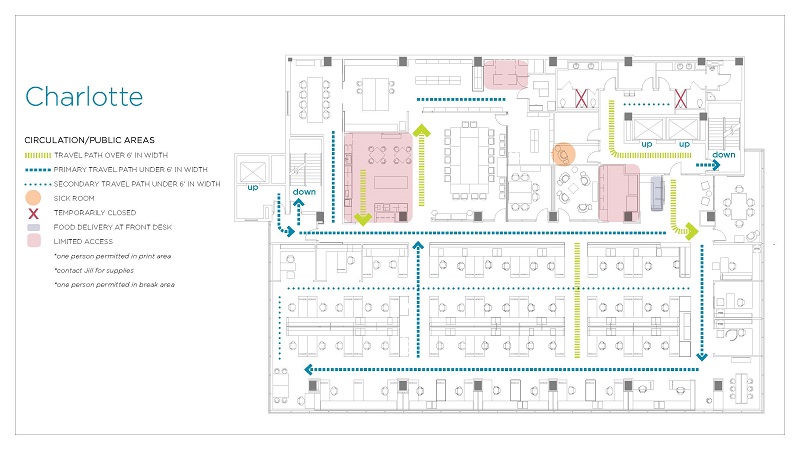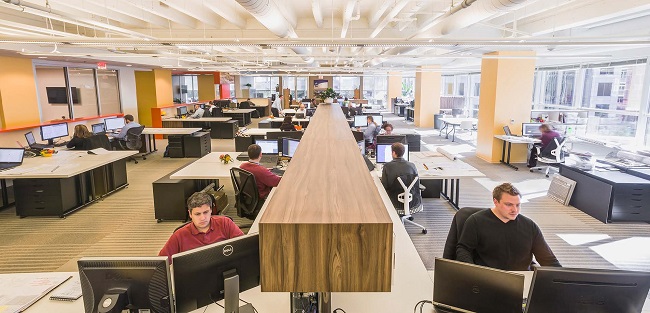
Preparing for Office Re-Entry: A Case Study
Since the beginning of our work-from-home experience, the workplace design team at Progressive AE has been focused on building a plan for our eventual office re-entry. Mitigating risk and keeping staff safe have been foundational to our efforts. To help guide our work, we made the decision early on to follow federal and state-issued guidelines, while considering what is best for our organization.
We know we can’t eliminate the spread of COVID-19, but we can take practical steps to limit exposure. Our primary responsibility is to keep staff safe both emotionally and physically. By feeling safe and comfortable with the return-to-work process, staff will be more productive and positive about protocol changes to the office environment.
We recognize that each organization is unique. The re-entry guidelines that best apply to Progressive AE may not to another workplace. There is no one-size-fits-all solution.
Know Your Why
The reason for office re-entry will vary for each organization. Having a clearly define reason for your organization will help staff have the confidence to determine when and how they participate.
At Progressive AE, we know we do our best creative work when teams can be together and collaborate in real-time. While it will be some time before we can truly connect in this way, we know we need to begin the process of understanding and working within our new normal.
With a clear understanding of why we would return to the office, we approached re-entry planning in three phases: evaluation, planning, and execution.
1. Evaluating our Current Conditions
Recognizing that every environment is unique, we started by evaluating our existing offices – one in Grand Rapids, MI, and the other in Charlotte, NC. In this evaluation, we identified the size of existing circulation routes and the density of people within spaces. This helped us see possible pinch points where social distancing guidelines would be difficult to maintain.
We realized our spaces could accommodate all staff in the workplace with few modifications while maintaining proper social distancing. However, the width of certain stairways and pathways did not allow for safe social distancing and, for initial re-entry, will be marked as one-way.

2. Planning for the Future
With a better understanding of our current state, we looked at modifications we would need to make while setting target density rates and strategies to safely seperate people. In our first phase of re-entry, we have targeted a 40% reduction in office density. This will allow individuals some movement at their workspaces, while also reducing the volume of users in shared spaces such as restrooms and meeting areas.
Planning efforts were done in tandem with our human resources department’s development of policies and procedures. These included facility updates for air circulation and touchless fixtures and identifying the employees who will return to the office in the first phase. While some things are essential requirements, our focus is on behaviors over protocol. How can we encourage people to stay safe and keep others safe as well?
While guidelines may change based on new information, below is a glimpse at some of the precautions Progressive AE will take throughout the various phases of office re-entry. These guidelines are by no means inclusive of all the safety measures that will be put into place.
Phase 1: Initial Steps
Reduce office density by 40%
No external visitors
Limit staff gathering to no more than 6
Staff are asked to wear masks while moving around the office
Phase 2: Intermediate Steps
Reduce office density by 20%
Certain external visitors are allowed including clients and partners
Limit staff gatherings to no more than 10
Staff may choose to wear masks while in the office
Phase 3: New Normal
No reduction in office density
Visitors are allowed but will be asked to self-report their health status
Virtual meetings will still be strongly encouraged when possible
Staff may choose to wear masks while in the office
3. Execute on Developed Plans
Our plans involve several action items that require careful coordination. Signage is important for helping employees understand how a space they know well should now be used. If people are moving workstations, we suggest scheduling shifts for employees to come in and pack or move to minimize interactions on the first day back to the office.
Below are examples of signage to be displayed throughout Progressive AE offices.





About Progressive AE – Progressive AE is a forward-thinking, employee-owned, national full services architecture and engineering firm that holds itself accountable to delivering strategic results – for our clients, our work, ourselves, and our environment. Headquartered in Grand Rapids, MI, Progressive AE has a regional office in Uptown Charlotte.





